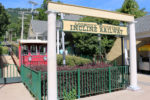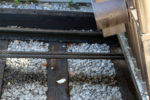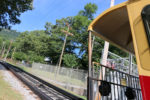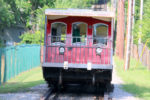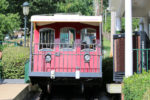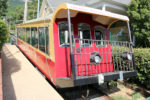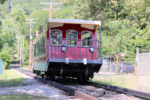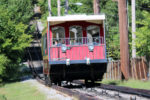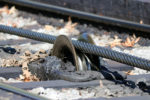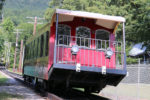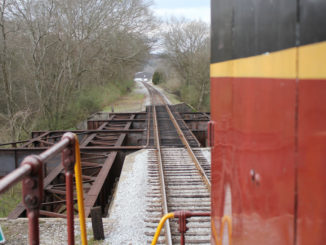
CHATTANOOGA, Tenn. — The Lookout Mountain Incline Railway is one of the most popular attractions in Chattanooga. But, the railroad is the last reminder of a once vibrant railroad scene that existed on Lookout Mountain.
The current incline railroad opened on Nov. 16, 1895. Interestingly, it was the second rail route to the top of the mountain, which in the decades following the Civil War transformed into a popular tourist attraction.
One popular hotel built atop the mountain, the Point Hotel, was built in the mid-1880s (possibly in 1886-87) and opened in May 1888. Once called a “Palace set upon a hill,” the Point Hotel was razed in 1913-14.
Construction on the Lookout Inn, started in 1887, and the hotel opened on June 2, 1890. This hotel, which was located across the street from the mountaintop station of the current incline railway, was destroyed by a fire on Nov. 17, 1908.
Below are brief profiles of the rail routes up to or on top of Lookout Mountain.
Lookout No. 1
The first railroad on Lookout Mountain opened in March 1887. The line featured a nearly consistent 27-degree incline and an 80-degree curve at one point in its route.
The narrow gauge, steam-powered route ran from the St. Elmo neighborhood at the base of Lookout Mountain to Lookout Mountain Battlefield Park, near where the current Incline Railway station is located, the line. The line connected with the Narrow Gauge Railroad at the Point Hotel on the top of Lookout Mountain.
While the line apparently enjoyed some level of success, the opening of Lookout No. 2 apparently was the death knell for the line. It closed on July 3, 1899.
Lookout No. 2 (current incline railroad)
The Lookout Incline and Lula Lake Railway opened the second line to the top of Lookout Mountain on Nov. 16, 1895. Originally coal powered, the standard gauge line was converted to a pair of 100 horsepower electric motors in 1911.
The 0.9-mile-long line, designed by Josephus Conn Guild Sr. and Lynn White, features a maximum grade of 72.7 percent, making it the steepest incline railway in the world. Because of this, the route has been called “America’s most amazing mile.”
While the railroad boasts no fatalities during its 120 years of operations, there have been several incidents that caused damage. There was one fire on Dec. 12 or 13, 1896, and another on March 24, 1919.
The 1919 fire destroyed the powerhouse, the upper station and the incline car parked at the top of the mountain. The Chattanooga Railway and Light Co. built a new car, and service was restored by the end of the year
The 1950s saw a revitalization of sorts for the railroad. It received new cars in about 1950, and a new station at the top of Lookout Mountain was built during the decade.
However, by the late 1970s, the Incline Railway was experiencing steep rider ship declines. Ridership in June 1979 was down 26.8 percent from a year earlier, according to an Associated Press article in the Oct. 26, 1979, edition of The Daily News of Bowling Green, Ky.
“It’s too important a part of the whole history of this area,” the news wire quoted the general manager of Chattanooga Area Regional Transportation Authority (CARTA) as saying. “It’s not something we take lightly.”
The Southern Coach Manufacturing Co. operated Lookout No. 2 until Jan. 28, 1973, when CARTA, which still operates the line, assumed control. In 1991, the railway was given Historic Mechanical Engineering Landmark status.
Broad Gauge (Chattanooga and Lookout Mountain Railway)
The Chattanooga and Lookout Mountain Railway was chartered in February 1887 and construction began on Sept. 15, 1887. Operations on May 28, 1888, and more than 10,000 people rode on the railroad on the opening day, according to report on page 7 of the June 9, 1888, edition of the Sunny South.
“The road is considered by railroad men to be a wonderful feat of engineering,” the newspaper noted. The road was apparently in operation a mere seven hours after workers drove in the last spike.
Passengers were able to ride in regular passengers cars for the 70-minute trip, which took a circuitous 10-mile-long route from St. Elmo to a station near the current terminus of the No. 2 incline.
Service on the route ended in 1897, and the owners of Incline No. 2 eventually purchased the line. A portion of the line on the top of the mountain was later purchased by the Chattanooga Railway and Light Co. and used as part of the Electric Trolley.
The route lives on today as the Guild/Hardy Trail.
Narrow Gauge Railroad (Mount Lookout Railway)
The Narrow Gauge Railroad was completed on July 1, 1887, and extended by September 1889. The road connected the Point Hotel and Sunset Rock.
“The road-bed, trestles, etc., of the Mount Lookout road are all of the heaviest timber ; the rails are of fifty-six-pound steel, with standard fastenings, and the ties are of oak laid eighteen inches apart,” according to an article in The Illustrated American, Volume 19. “The tracks on steep grades have longitudinal stringers under the ties, resting on cross sills, securely anchored to prevent ‘creeping.’”
The publication also noted:
When the ascending car reaches the summit it strikes a lever attached to one of the brakes, and at the same time closes the throttle of the engine, making sure of a complete stop, whether the engineer is attending to his duty or not. There are two cables. one and one-quarter inches in diameter, attached at either end to one of the two cars. The attachment is so made that if either cable should break or slip the fastening of the other will not be affected, but the automatic clutch under the car will be thrown into action. This clutch engages with a wooden guard-rail bolted to the track, and wedges tighter and tighter with any downward motion of the car. It is a new device, and was designed especially for this incline. The cables are not what are known as continuous cables, but are so arranged that the descending car is moved by its own weight.
The entire road will be lighted by electricity, and will collect its own water supply from springs. The cars are substantially built, thirty-two feet long, finished inside with oak, with swinging seats, and can be made close in cold weather or open during the summer.
The line was apparently closed by 1900.
Electric Trolley
The Electric Trolley ran from Natural Bridge to Point Lookout via Sunset Bridge, using a portion of the old Broad Gauge right-of-way.
The trolley saw its need justified following a 1919 fire on Lookout No. 2, and regular trolley ran until 1920. Reduced service ran over the line until Feb. 25, 1924, when the line was abandoned.
Sources
- Various historic newspaper archives and historical markers
- American Society of Mechanical Engineers (ASME)
- Walker, Alan. Railroads of Chattanooga. Arcadia Publishing, 2003.
- Georgia’s Railroad History and Heritage (Chattanooga & Lookout Mountain Railway), accessed Aug. 2, 2015.
- Chattanoogan.com (Chattanooga Railroad Series: The Broad Gauge Railroad), accessed Aug. 3, 2015.
- (The History of Chattanooga and Lookout Mountain), accessed Aug. 2, 2015.
- Nooga.com (Lost Chattanooga: The historic hotels on Lookout Mountain (part two)), accessed Aug. 3, 2015.

